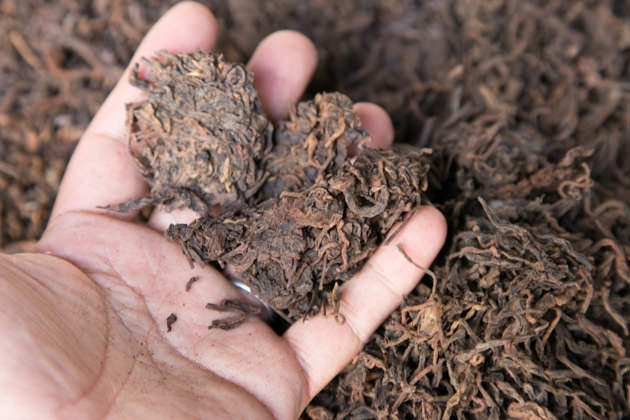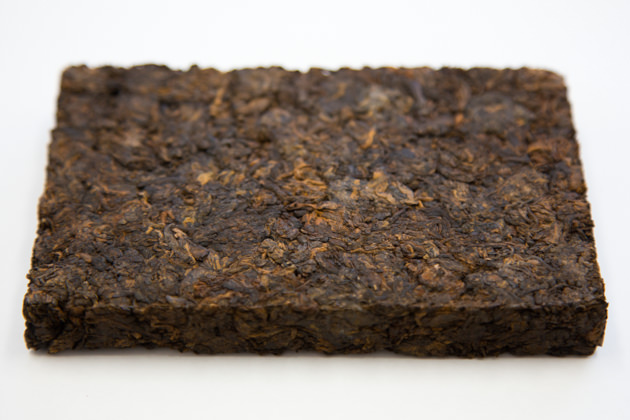- HOME >
- New Arrival at HOJO Online Shop
New Release of Cha Tou Ripe Pu-erh Tea 2015
- [2017.02.24] Posted By Akira Hojo
We purchased Cha Tou 2015 when we visited Yunnan in 2016. This tea was produced in the village located about 50km away from the Myanmar border. The tea was grown with the natural farming method which no pesticide or fertilizer is used.

Even after the compression we still can observe the Cha Tou
Cha Tou is the lumps of tea produced by microorganism during tea fermentation
Cha Tou means “the head of tea” in both Chinese and Japanese. Technically, Cha Tou is the lumps of tealeaf coagulated during the fermentation due to the polysaccharide produced by the microorganism. There is no oxygen inside Cha Tou. Because of this fact, it undergoes very unique maturation during the process.


Small Cha Tou
Small Cha Tou
There are two types of Cha Tou: the big Cha Tou and the small Cha Tou. Sometimes the tea manufacturer even classifies it into three categories. They may have mini Cha Tou as well. We used big Cha Tou for our earlier lineup, the Cha Tou Ripe Pu-erh 2012. However, we selected small Cha Tou for 2015 crop. The size of the small Cha Tou is about 1cm or slightly bigger.

It is extremely rare to make ripe pu-erh tea from spring tea
The majority of the ripe pu-erh tea is produced after blending all batches of tea collected in late spring, summer and autumn tea. The manufacturer conducts blending in order to even out the price and the overall quality. This is the typical production style of ripe pu-erh tea in big factory with mass production scale.
In other words, it’s extremely rare to find ripe pu-erh tea produced from only spring tealeaf in commercial tea market. If you have ever tried the ripe pu-erh tea produced from the spring crop, there is a huge difference in quality compared to the blended tea. The spring tea gives a mellow and silky soft drinking sensation with long lasting sweetish aftertaste.
Our tea is always from the spring crop. Every year we visit the tea manufacturer in early spring to look for the spring tea.

Ripe pu-erh tea was invented in 1970s. It has a very short history as compared to the raw pu-erh tea that has more than 700 years of history. However, in oversea market, a lot of people associate ripe pu-erh tea as the “pu-erh tea”. The ripe pu-erh tea is produced by the microbiological fermentation. During the fermentation, the substance that gives astringency such as EGCg is being oxidized and decomposed.
If tea is produced from early spring crop, regardless of raw or ripe pu-erh tea there is no astringency. On the other hand, if raw pu-erh tea is produced from summer tea, it gives strong astringency. However, once the summer tea is fermented into the ripe pu-erh tea, it gives no astringency thanks to the reason mentioned above. Consequently, summer tea-based ripe pu-erh tea is well accepted and often more famous than raw pu-erh tea in oversea market.
Earthy smell is due to the failure of process management
Many people commented that ripe pu-erh tea tends to give earthy flavor like old furniture smell or soil. This type of smell is called camphor smell that gives impression like traditional Chinese medicine. In fact, this smell is developed if ripe pu-erh tea is not produced in a proper manner. It is due to the failure in fermentation.
There are a number of microorganisms that involves in the fermentation of ripe pu-erh tea. Usually the anaerobic and aerobic bacteria actively involved in the initial stage and subsequently it is taken placed by the yeast and mold. However, if too much water is being applied, tea leaves are over wet and there is insufficient oxygen. As a result, anaerobic bacteria dominate the fermentation and it will produce substances that give unpleasant smell.
We never purchase tea once we detect camphor smell. Unfortunately, a lot of pu-erh teas are poorly made and gives earthy smell. That is the reason why a lot of people have negative impression with ripe pu-erh tea. The well-produced ripe pu-erh tea gives sweet dry-fruity flavor.
Aging further enhances the flavor of Cha Tou
The Cha Tou is giving a mild sweet fruity flavor even if tea is still fresh.
However, the best timing to drink this tea is after being kept for a few years (if tea is kept in warmer climate. In case the tea is kept under cooler environment, the maturation will takes longer period of time).
It develops very unique and complex flavor like dried dates with a hint of raisin note.
Related Articles
How to get the latest update on HOJO?
1. Follow Twitter, 2. Click "Like" on Facebook, and 3. Subscribe in newsletter. You can have the latest tea news from HOJO.
 Subscribe the Newsletter to enjoy the privileges
Subscribe the Newsletter to enjoy the privileges- You may receive a free sample upon purchase, or you may have the priority to purchase special products. So please remember to subscribe our newsletter as well as the social network.
- Myanmar White Tea Bud 2013 from Guo Gan, Myanmar
- We have released a raw Pu-erh tea, 緬甸白芽茶 2013 (Myanmar White Tea Bud 2013), produced by ethnic minorities in t …
- Yong De Wild White Tea 2025 Loose Leaf Limited Release
- We have released Yong De Wild White Tea Loose 2025. For the 2025 harvest, only the loose-leaf type was …
NEW ARTICLES
 Myanmar White Tea Bud 2013 from Guo Gan, Myanmar
Myanmar White Tea Bud 2013 from Guo Gan, Myanmar- We have released a raw Pu-erh tea, 緬甸白芽茶 2013 (Myanmar White Tea Bud 2013), produced by ethnic minorities in t …
 Yong De Wild White Tea 2025 Loose Leaf Limited Release
Yong De Wild White Tea 2025 Loose Leaf Limited Release- We have released Yong De Wild White Tea Loose 2025. For the 2025 harvest, only the loose-leaf type was …
 Experience the True Freshness of Raw Pu-erh : Tang Jia 2025 Loose Leaf Release
Experience the True Freshness of Raw Pu-erh : Tang Jia 2025 Loose Leaf Release- We have released Tang Jia Raw Pu-erh Tea 唐家古樹生茶 2025 Loose Leaf. Among HOJO’s raw pu-erh teas, Tang Jia Raw Pu …
 Yunnan Chun Jian Green Tea from High Mountain Gardens
Yunnan Chun Jian Green Tea from High Mountain Gardens- Yunnan Chun Jian Green Tea is now available. This tea is made from naturally grown leaves harvested from high …
 Limited Loose Leaf Release of 2025 Da Xue Shan Wild Raw Pu-erh Tea
Limited Loose Leaf Release of 2025 Da Xue Shan Wild Raw Pu-erh Tea- We have released the 2025 loose-leaf version of Da Xue Shan Wild Raw Pu-erh Tea. This tea comes from wild tea …
 Discover a New Way to Enjoy Tea: Cooking Rice with Tea
Discover a New Way to Enjoy Tea: Cooking Rice with Tea- Cooking rice with tea is a simple idea, but it brings surprisingly satisfying results. The tea’s flavour seeps …
 2025 Da Xue Shan Wild White Tea Now Available from Yunnan
2025 Da Xue Shan Wild White Tea Now Available from Yunnan- The 2025 harvest of Da Xue Shan Wild White Tea is now available. Crafted from truly wild Camellia taliensis tr …
 Fresh 2025 Yunnan White Tea – Select Your Favourite Lot Before Blending
Fresh 2025 Yunnan White Tea – Select Your Favourite Lot Before Blending- Freshly crafted in Yunnan and just arrived in KL, our new 2025 white tea is now available at our Gardens Mall …
 2024 Dong Shan Raw Pu-erh Tea – Crafted with the Producer for Desired Quality
2024 Dong Shan Raw Pu-erh Tea – Crafted with the Producer for Desired Quality- We have released the 2024 cake of Dong Shan Raw Pu-erh Tea. Earlier, we offered the loose-leaf version from th …
 Development of Firewood Roasted Hojicha Using Naturally Grown Tea from Yunnan
Development of Firewood Roasted Hojicha Using Naturally Grown Tea from Yunnan- We are currently staying in Yunnan Province for tea production. As the season nears its end, tea trees with pa …
Category
- New Arrival at HOJO Online Shop
- Featured Articles
- Newsletter
- Types of Tea
- Origin of Tea
- Teapot and Tea Equipment
- Tea Column
- How to enjoy tea
- Tea Processing
- How to choose quality tea
- Tea constituents and functional effect
- Safety of Tea
- Foods
- Tea Business Operation
- Hobby and Outdoor Activity
- Ranking of Tea
- Video
- FAQ
- Media Release
Profile

- AKIRA HOJO
- I invite you to experience my tea selections.I was born in Nagano, Japan. In university, I studied agricultural chemistry, and I have the master degree in food science. I worked in Japanese food industry for 10 years. I involved in R&D, QC and QA. As a factory manager, I implemented ISO9000 series and managed the factory.
- The Art of Tea Magazine
- We posted the article on “The Art of Tea Magazine No.9, the magazine is published in Taiwan. We featured …
- New Straits Times
- The Malaysian National Newspaper, New Straits Times featured HOJO Tea on 17-Oct-2007.
Shop Info

Address:Lot No. T-215, 3rd Floor, The Gardens Mall, Mid Valley City, Lingkaran Syed Putra, 59200 Kuala Lumpur
Tel: +603-2287-4537
Business Hour: 10am to 10pm

















